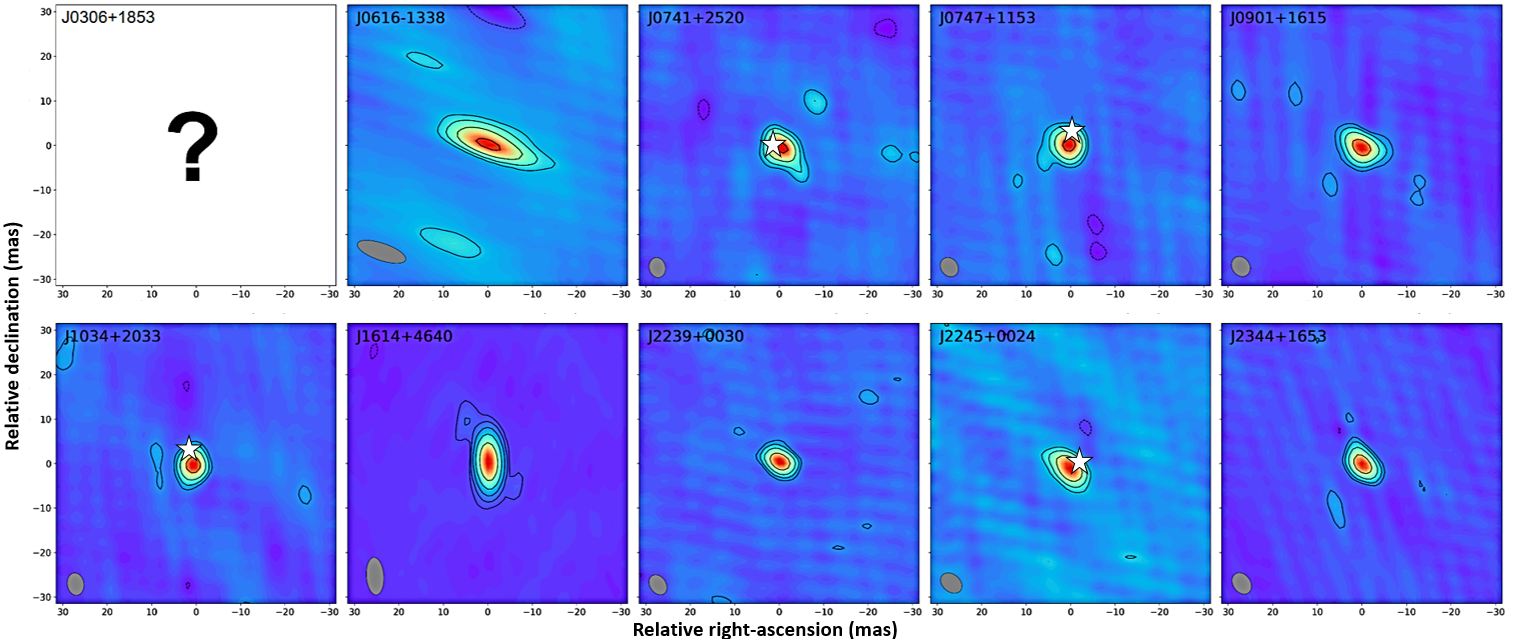
Revealing faint compact radio jets at redshifts above 5 with very long baseline interferometry
Máté Krezinger
High-redshift radio quasars (z > 5) are unique probes of the early Universe. Radio quasars are accreting supermassive black holes which eject powerful relativistic plasma jets. They are extreme luminous objects seen even from the high-redshift Universe, therefore able to provide insights into the formation and evolution of the first galaxies and supermassive black holes. Even from these distances, VLBI can reveal the compact innermost parts of the radio-emitting relativistic jets on millarcsecond (mas) scale. To date, only a dozen of the known quasars have been observed with VLBI at redshifts z > 5 (e.g. Perger et al., 2017).
We targeted 9 faint radio emitters with the lowest radio luminosity from a catalogue of known z > 5 quasars (Ross & Cross, 2020) which were not observed with VLBI yet. Another aspect was to select sources with different radio-loudness indices covering the radio-quiet and radio-loud regimes. A 10th, radio-quiet target J0306+1853 was also included in the experiment. J0306+1853 was previously examined by Sbarrato et al. (2021b) using the Very Large Array (VLA) and suspected to host a compact jet. With this sample, we aimed to investigate how radio-loudness (i.e. the radio-to-optical luminosity ratio) affects the jet physical parameters.

Figure 1. The naturally weighted EVN 1.7-GHz VLBI images of the radio quasars. J0306+1853 remained undetected at this resolution. The grey ellipses are the beams and are representing the resolution of the array. The white star symbols represent the Gaia optical positions (when available) and their uncertainties can be considered ~1 mas.
The targets were observed in 2022 June and October at 1.7-GHz with the European VLBI Network combined with the e-MERLIN. Except for the faintest one, J0306+1853, all quasars have been detected with a single compact component (see Fig. 1). The detection rate of compact pc-scale jets in our radio-quiet quasars is 3 out of 4 sources. None of the sources show Doppler-enhanced emission and their derived radio powers are typical of Fanaroff-Riley II radio galaxies and quasars. In addition to the VLBI radio observations, we collected low-resolution radio data from the literature to investigate the total radio specra. The Gaia optical astrometric mission detected five of our sources (includingJ0306+1853), and we found the Gaia−VLBI positional offsets to be insignificant, which indicates that the detected radio features could be related to the inner jet, located close to the central engine.
We examined a larger sample of radio quasars to see whether the radio-loudness affects the jet physical parameters. We collected data of other z > 5 quasars, including radio-loudness indices (R), 1.7-GHz core brightness temperatures(Tb), 1.7-GHz total and core monochromatic radio powers (Ptotal and Pcore). The core brightness temperatures and monochromatic radio powers seem to increase with increasing radio loudness (see Fig. 2). However, for the R−Tbrelation, the radio-quiet and the extreme radio-loud regimes are still undersampled. Obtaining high-resolution VLBI observations for more z > 5 radio quasars would be desirable as it would further constrain these relations.

Figure 2. Relations between physical parameters. The new sources presented in this study are marked with red triangles. Left: The redshift-corrected 1.7-GHz brightness temperatures as a function of radio-loudness. Right: The comparison of 1.7-GHz core monochromatic radio power and the 1.7-GHz total monochromatic radio power for z > 5 sources where both values are available. The dashed line represents the Ptotal = Pcore.
References:
Perger et al., 2017, FrASS, 4, 9
Ross & Cross, 2020, MNRAS, 494, 789
Sbarrato et al., 2021b, A&A, 655, A95
More information: Krezinger et al., 2024, A&A, Volume 690, A321, 14
Contact: Máté Krezinger, krezinger.mate@csfk.org